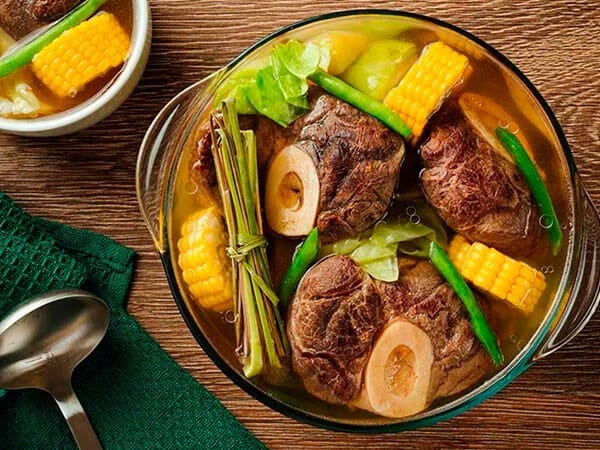Experience Filipino Culture with Traditional Filipino Food Recipes.
Experience Filipino Culture with Traditional Filipino Food Recipes.
Blog Article
Genuine Filipino Food Recipes to Try in the house
Discovering authentic Filipino food recipes offers a possibility to appreciate the detailed tastes and social importance behind each meal. Using fresh, local active ingredients is crucial, as is welcoming communal eating-- a hallmark of Filipino culture.
Popular Filipino Dishes
Filipino food flaunts an abundant tapestry of tastes and practices, with over a lots famous recipes that highlight the country's diverse social influences. One of the most popular recipes is Adobo, a savory stew commonly made with hen or pork, marinated in vinegar, soy sauce, garlic, and spices. Its tangy flavor profile makes it a staple in Filipino houses.
Another beloved meal is Sinigang, a sour soup commonly made with tamarind, tomatoes, and various veggies. This dish can feature pork, shrimp, or fish, and its refreshing preference is ideal for warm climates. For those with a craving for sweets, Leche Flan-- a creamy sugar custard-- serves as a popular dessert, showcasing the Filipino fondness for rich, wonderful tastes.
Kare-Kare, a hearty oxtail stew with a thick peanut sauce, along with the famous lumpia, or springtime rolls, further exhibit the variety found in Filipino food. Each recipe not just provides unique preferences however also narrates of regional components and historical influences, making Filipino food a vibrant reflection of its culture and heritage.
Important Active Ingredients for Filipino Food Preparation
The significance of Filipino cooking hinges on its essential components, which work as the foundation for the country's cherished recipes. A selection of tastes and textures collaborated, showcasing the varied social influences that form Filipino cuisine.
Secret ingredients include rice, the staple that accompanies virtually every dish, signifying sustenance and area. Soy sauce, vinegar, and fish sauce (patis) are essential for seasoning, conveying umami and deepness to meals. Fresh natural herbs like cilantro and basil add aromatic quality, while garlic, onion, and ginger offer a durable flavor base.
Healthy protein sources such as pork, poultry, and fish and shellfish are central to lots of recipes, typically marinated to boost preference. Veggies like eggplant, bitter melon, and eco-friendly beans add necessary nutrients and balance - Filipino food recipes. Coconut milk is another significant component, lending creaminess and a refined sweetness to different stews and desserts
Last but not least, calamansi, a citrus fruit, uses a revitalizing flavor that boosts recipes and beverages alike. Together, these ingredients produce the vivid and abundant tapestry of flavors that define Filipino food, imp source making it both comforting and unique. Understanding these principles is vital for any person looking to replicate authentic Filipino dishes in your home.
Step-by-Step Dish Overview

Start by preparing your active ingredients. For Adobo, cut the meat into uniform pieces and season it in soy sauce, vinegar, garlic, and bay leaves for at the very least 30 minutes. Next, warmth oil in a frying pan and sauté the garlic and onions up until great smelling, after that add the seasoned meat, allowing it to brown evenly.
For Sinigang, begin by boiling water in a pot and adding your choice of meat. Once tender, integrate tamarind paste or fresh tamarind for that signature sour taste. Adhere to with vegetables like radish and kangkong, cooking until just tender.
:max_bytes(150000):strip_icc()/Filipino-Features-Soups-and-Stews-1e81ba12ce10481caf3ff58981c347ab.jpg)
Tips for Authentic Taste
Often, accomplishing click for info authentic flavor in Filipino meals depends upon the cautious selection and therapy of ingredients. Start with fresh, high-quality produce, as the vibrancy of vegetables and herbs significantly boosts the recipe's overall taste. Staples like garlic, onions, and ginger create the fragrant foundation for many dishes; using them in proper percentages is essential.
Choosing the right protein is similarly essential. For instance, conventional adobo usually employs hen or pork, marinaded to absorb the marinade's complete flavor. Additionally, take into consideration sourcing in your area produced or local ingredients, as they can give authenticity that store-bought alternatives do not have.
Food preparation techniques also play an essential duty. Slow-cooking methods, such as braising or stewing, enable tastes to blend magnificently, while frying can include a satisfying texture. Do not ignore seasoning; utilizing salt, fish sauce, or soy sauce at the ideal moments can raise a dish significantly.
Offering and Delighting In Filipino Food
Cooking click site experiences are enriched when Filipino food is offered with attention to tradition and neighborhood. The method of sharing dishes is central to Filipino culture, signifying unity and friendliness. When serving Filipino dishes, think about utilizing conventional serveware, such as clay pots or bamboo baskets, which improve the credibility of the experience.
Normally, Filipino dishes are taken pleasure in family-style, with a selection of dishes put at the center of the table. This communal strategy encourages interaction and permits guests to sample various tastes. A well-curated spread could consist of staples like adobo, sinigang, and lumpia, complemented by rice, which is an essential element of every dish.
Accompanying the food with traditional dressings, such as soy sauce, vinegar, or chili paste, can raise the dining experience, inviting restaurants to tailor their plates to their choices. In addition, incorporating local drinks, like calamansi juice or tuba, can enhance the general flavor account.
Final Thought

Report this page